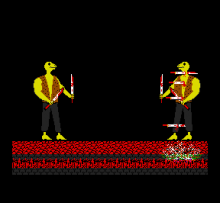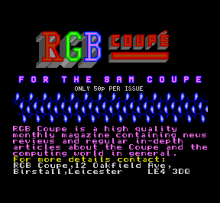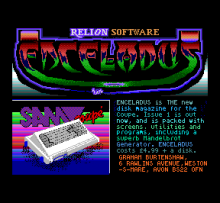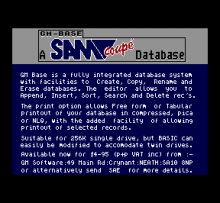Fred 6
Disk Magazine
Submitted by Dan Dooré on Thursday, May 17, 2018 - 13:35.
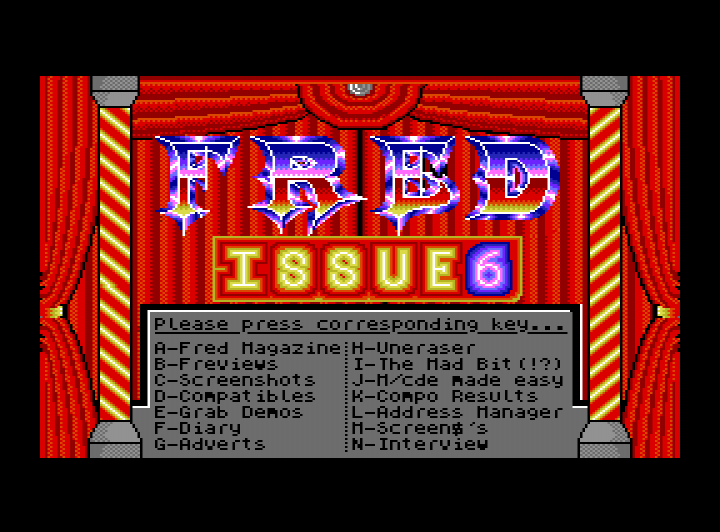
Download
Release Year
1990
Copyrights
Copyrights Granted
Copyright Provenance
Description
Issue 6
| Item | Author | Description |
|---|---|---|
| Menu | Brian McConnell | |
| Magazine | One Meg available, news roundup | |
| Freviews | Pipe Mania, Sam IBU, LERM SAM Assembler, Search: “Ditchscape” | |
| Screenshots | Search: “Ditchscape”, Lizard wars | |
| Compatibles | The Shadow | Sam-compatible spectrum titles |
| Grab demos | Brian McConnell | Demos of what can be done with grab |
| Diary | Steve Taylor | Keep a diary on your sam |
| Uneraser | Colin MacDonald | Retrieve erased files |
| The Mad Bit | Brian McConnell | Pointless drivelling nonsense! |
| MC made easy | Steve Taylor | Machine Code Made Easy - Part 1 |
| Compo results | Results of an earlier competition | |
| Address manager | Joao Nuno Coelho | Store names and addresses |
| Screen$ | Malcolm Phillips | Converted pictures |
| Interview | Colin MacDonald | Interview with Brent Stevens of the SCPDSA |
Magazine
CONTENTS 1
1 : CONTENTS 11 : THE PD SECTION
2 : EDITORIAL 12 : LETTERS
3 : NEWS 13 : LETTERS
4 : HINTS 'N' TIPS 14 : LETTERS
5 : HINTS 'N' TIPS 15 : LETTERS
6 : QUESTIONAIRE 16 : LETTERS
7 : THE MEANING OF LIFE 17 : SCPDSA
8 : THE MEANING OF LIFE 18 : ENCELADUS
9 : THE MEANING OF LIFE 19 : SORRY!
10: THE PD SECTION 20 : CREDITS
REMEMBER , C FOR COLOURS AND SPACE TO SELECT PAGE.
EDITORIAL - ISSUE SIX 2
WELCOME TO ANOTHER ISSUE OF YOUR FAVOURITE DISK-BASED MAGAZINE,
FRED. THIS MONTH IS A VERY IMPORTANT MONTH FOR US, AS IT'S THE
FIRST TIME WE'VE HAD TO COPE WITHOUT ANY HELP WHAT-SO-EVER. THIS
IS BECAUSE COLIN HAS EXAMS COMING UP,AND OF COURSE DOES NOT WANT
TO FAIL THEM. I HAVE EXAMS TOO, BUT AM NOT THAT FUSSED ABOUT
STUDYING YET ( GUESS WHO'S GOING TO FAIL!!).
THIS MEANS THAT IT'S UP TO IAN AND ME TO KEEP THE MAG GOING.
ACTUALLY, IT WAS SUPPOSED TO BE OUR RESPONSIBILITY LAST TIME, AS
COLIN WENT ON HOLIDAY, BUT HE STILL ENDED UP DOING THE LION'S
SHARE OF THE WORK. FORTUNATELY, THE FACT THAT YOU ARE READING
THIS EDITORIAL IS WITNESS TO THE FACT THAT WE HAVE MANAGED
SOMEHOW TO FINISH THE ISSUE. (THAT'S A LAUGH! - CM)
THIS MONTH, WE INTEND TO MAINTAIN THE SORT OF QUALITY YOU'VE
HOPEFULLY COME TO EXPECT, AND PERHAPS EVEN IMPROVE UPON IT.
WHATEVER THE OUTCOME YOU CAN BE SURE THAT WE'VE TRIED OUR BEST.
HAPPILY, OUR READERSHIP IS STEADILY INCREASING, AND THANKS
TO A WONDERFUL REVIEW IN CRASH AND POSSIBLY A MENTION IN THE
NEXT SAMCO NEWSLETTER, THE READERSHIP FIGURES COULD TAKE ON AN
EXPONENTIAL RISE. ENJOY FRED!! BRIAN ,EDITOR OF EDITIRIAL!!
NEWS 3
THIS MONTH IS NOT ONE OF GREAT REVELATION, BUT THERE ARE A
COUPLE OF INTERESTING POINTS. FIRSTLY, THE 1-MEGABYTE MEMORY
UPGRADE SHOULD BE AVAILABLE BY NOW. IN THEORY, WITH THE RIGHT
SOFTWARE, 1 MEG COUPE OWNERS SHOULD BE ABLE TO COPY A DISK IN
ONLY TWO DISK SWOPS. ALSO SCHEDULED FOR THE START OF DECEMBER
IS THE CARD CAGE. THIS LITTLE DEVICE WILL SERVE THE SAME PURPOSE
AS AN ELECTRICITY ADAPTOR IN THAT IT WILL ALLOW YOU TO USE 4
INTERFACE - REQUIRING PIECES OF HARDWARE AT THE SAME TIME.
UNFORTUNATELY FOR ANY BUDDING ARTISTS AND ANYBODY ELSE WHO
WOULD LIKE TO SEE THE SAM MOUSE IN ACTION, THIS IMPORTANT
PERIPHERAL WILL NOT BE AVAILABLE UNTIL SOMETIME NEXT YEAR, MARCH
HOPEFULLY. THIS IS BECAUSE THE COMPANY WHO WERE TO START
PRODUCING THE ASIC CHIP FOR IT HAVE, IN TRUE MGT STYLE, "GONE
UNDER." SO IT LOOKS LIKE WE SHALL JUST HAVE TO WAIT.
PLANNED FOR NEXT YEAR ARE TWO DIGITISERS FROM BLUE ALPHA
ELECTRONICS (THE MAKERS OF THE AVAILABLE-NOW VOICE SYNTHESISER).
THESE ARE AUDIO DIGITISER IN JANUARY AND A VIDEO DIGITISER A FEW
MONTHS LATER. I'M SURE WE'RE ALL LOOKING FORWARD TO THEM!!
HINTS 'N' TIPS 4
I'M SURE THAT A LOT OF YOU ARE RATHER FED UP OF TYPING IN EACH
AND EVERY KEYWORD LETTER BY LETTER, SO YOU MAY FIND THIS LITTLE
TIP HELPFUL. SOME OF YOU WILL UNDOUBTEDLY KNOW THIS, BUT FOR
THOSE WHO DON'T, HERE GOES.
WHILE ALMOST EVERYBODY KNOWS THAT THE FUNCTION KEYS ACT AS
COMPLETE COMMANDS, SOME OF THE NORMAL KEYS ALSO HAVE THIS. FOR
EXAMPLE THE LETTER "S" WHEN PRESSED TOGETHER WITH SYMBOL WILL
PRODUCE THE KEYWORD "SAVE". THERE ARE MANY MORE OF THESE
"HIDDEN" KEYWORDS, AND I'LL LEAVE YOU TO FIND THEM YOURSELVES...
SOMETHING THAT THE MORE SERIOUS USERS AMONG YOU MIGHT LIKE
IS THE ABILITY TO GET A DIRECTORY OF ALL THE FILES ON A DISK
WITH A SET PREFIX / SUFFIX. FOR EXAMPLE, TO FIND ALL THE FILES
BEGINNING WITH "ABC" YOU SHOULD TYPE IN . SIMILARLY, TO FIND ALL THE FILES ENDING IN "ABC" YOU WOULD TYPE IN
Reviews
BRIAN SAM IBU
SAM IBU IS YET ANOTHER COPYING PROGRAM, BUT WITH A DIFFERENCE.
ALTHOUGH IT CAN COPY COMPLETE DISKS LIKE ANY OTHER COPIER, THIS
CAN DETECT THOSE FILES WHICH ARE PRESENT ON THE SOURCE DISK AND
IF THERE IS A FILE ON THE TARGET DISK WITH THE SAME NAME, IT
WON'T BOTHER TO COPY IT. THAT IS, IF YOU HAVE FRED AS A SOURCE
DISK AND A DISK WITH ONLY SAMDOS ON IT, SAM IBU WILL COPY THE
WHOLE OF FRED EXCEPT SAMDOS.
SIMPLE REALLY. APART FROM THAT, SAM IBU IS A FAIRLY FAST
SECTOR COPIER. IF YOU HAVE ONLY ONE DRIVE IT IS STILL A FAST WAY
TO COPY DISKS.
ALTHOUGH HARDLY AN INCREDIBLY DIFFICULT UTILITY TO USE, I
FOUND IT LEFT SLIGHTLY TOO MUCH TO THE USER'S INGENUITY.
TO SUM UP, USEFUL IF YOU HAVE TO KEEP UPDATING A DISK WITH
FILES FROM A WORDPROCESSOR OR SOME SUCH THING, BUT I USE
THE SDC COPIER THE MOST.(ALSO REVIEWED THIS ISH)
GRAPHICS- N/A VALUE - AT ONLY £3.50, WORTH BUYING
SOUND - N/A
ORDER FROM: SD SOFTWARE,[redacted]
Assemblers, eh? Useful, aren't they? I mean, you can write
machine code, read machine code and, um, well that's about it
really. But if you're serious about programming (or just want to
look intelligent) it's an essential piece of kit.
In fact, assemblers were just about the first pieces of software
to come out for the Coupé and LERM have set the standard with
theirs. So let's take a look, shall we?
Firstly, it's only supplied on tape. There is an option to copy
the program onto disk, though, so remember to get a spare one.
The program itself runs on 256K and 512K versions although there
is very little difference between the two versions.
There are two main parts to it: The assembler itself and a help
page/disassembler/toolkit section.
ASSEMBLER: A very useful feature of this particular program is
that if you own LERM's Speccy assemmbler, code from
that can be loaded in and modified. The assembler
has a full-screen editor and will accept code in a
form similar to BASIC. ie there is no need to TAB
everything out into fields.
Decimal, hex and binary numbers are all accepted and
labels can be up to 12 chars in length. Comment
lines and directives such as EQU, DB and DS are also
accepted.
The assembly process itself is extremely quick and
commands exist for auto-lining, renumbering and
finding certain strings in the text.
Two source files each 32K long are present and can
be used independantly or merged together.
My only criticisms are that the bright white on
black text strains the eyes and can't be changed.
The LIST command only works with line numbers so if
you want to see a subroutine you must either know
its line number of FIND it and then LIST.
OTHER BITS: The help page is independant of the assembler and
they can be switched between with no ill effect.
Some of the facilities include:- number conversion;
ASCII/number dumps; mnemonical disassembly
This is probably the feature of LERM SAM Assembler
that makes it stand out from the crowd. It's printer
compatable and vey well thought out.
*****************************###########
* >>>> FAX BOX <<<< #100% #
* # #
* LERM SAM Assembler. # -- #
* Price: £8.99 (tape only) # -- #
* # -- #
* RATING >>>> 80% <<<< # 50% -- #
* # -- #
*****************************# -- #
# -- #
# -- #
# 0% -- #
###########
PIPEMANIA
YES, THE ONE WE'VE ALL BEEN WAITIN FOR - PIPEMANIA FOR THE
COUPE!! THIS WAS ONE OF THE MOST WIDELY ACCLAIMED GAMES OF THE
YEAR, AND IT'S ALSO THE FIRST REALLY BIG GAME TO MAKE IT ONTO
THE COUPE.
THIS VERSION IS THE SAME AS ALL THE OTHERS IN THAT YOU MUST
KEEP ADDING PIPES TO THE END OF THE MAIN FLOW SO THAT THE WATER
DOES NOT REACH THE END OF YOUR NETWORK. I'M SURE YOU'VE ALL
HEARD/READ/SEEN THAT A GOOD FEW THOUSAND TIMES. WHAT MAKES THIS
DIFFERENT FROM ANY OTHER OF THE 8-BIT VERSIONS IS THE ENHANCED
GRAPHICS. IN MODE 4, THESE ARE EASILY COMPARABLE TO THOSE OF THE
ST, PERHAPS EVEN BETTER...
IF YOU HAVE THE SPECCY VERSION, THERE'S MAYBE NOT AS MUCH
POINT IN BUYING THIS, BUT IF NOT GO FOR IT!
GRAPHICS - 85% PLAYABILITY - 92%
SOUND - 76% ADDICTIVITY - 93%
OVERALL - 91% VALUE - 84%
IF YOU DON'T HAVE THE SPECCY VERSION,GET THIS
CORKER. YOU WON'T REGRET IT!
BRIAN SDC BIT COPIER
THIS IS A DISK COPIER FROM SDC (AS THE TITLE MAY SUGGEST...) AND
IS ONE OF THE BEST. IT IS A SIMPLE PROGRAM (WRITTEN IN BASIC
WITH A BIT OF CODE) WHICH IS VERY STRAIGHTFORWARD TO USE. THIS
COPIES ONLY ENTIRE DISKS, OVERWRITING ANYTHING ON THE TARGET
DISK. USERS WILL ONLY NEED TO CARRY OUT SIXTEEN DISK SWOPS IN
TOTAL, 512K USERS ONLY EIGHT (NOTE: THERE IS NO PROVISION FOR
USERS WITH 2 DRIVES). THIS IS THE QUICKEST COPIER I'VE SEEN,
COPYING AN ENTIRE DISK IN JUST UNDER 3 MINUTES. IT IS PRESENTED
WELL (NOT MUCH POINT, BUT LOOKS GOOD) AND HAS A NICE LITTLE BAR
WHICH FILLS WITH COLOUR AS THE DISK IS READ.
OVERALL, THIS IS MY FAVOURITE COPIER (AND THE OFFICIAL FRED
COPIER!!).
GRAPHICS- N/A VALUE - A GOOD BUY AT ONLY £2.75
SOUND - N/A
AVAILABLE FROM : BRIAN MUMFORD , [redacted]
COLIN : AND DON'T MENTION FRED THIS TIME!!!
Previews
COLIN PREVIEWS ANCO'S LONG AWAITED KICK OFF 2 IS ALL SET TO BE RELEASED IN JANUARY '91 AND BOTH THE AMSTRAD AND SPECTRUM VERSIONS ARE SUPPOSEDLY EXCELLANT (YS GAVE IT 80% BUT WE ALL KNOW HOW BADLY THEY REVIEW THEIR GAMES DON'T WE?). ENIGMA HAVE JUST ABOUT FINISHED PROGRAMMING THE DOMARK HIT , "KLAX" ALTHOUGH THERE ARE NO DATES AS YET IT SHOULD BE HITTING THE SHOPS SOON (THE COUPLE THAT DO STOCK COUPE GAMES THAT IS!) PRICED AT £14.99 FOR DISC. ACCORDING TO PAST DETAILS , EFTPOTRM (THAT'S "ESCAPE FROM THE PLANET OF THE ROBOT MONSTERS" TO YOU!) AND TRIVIAL PURSUIT SHOULD BE OUT ANY TIME NOW BUT I PRESUME THEY'LL BE OUT JUST AFTER THE NEW YEAR.PRICES ARE £14.99 AND £19.99 RESPECTIVELY. UNFORTUNATLY THERE DOSN'T SEEM TO BE MANY MORE GAMES ON THE NOT TOO DISTANT HORIZON THAT I COULD WAFFLE ON ABOUT SO WHAT I WILL SAY IS THAT THE NEXT SAMCO MAILSHOT SHOULD BE OUT ANY DAY NOW AND I WAS TOLD THAT FRED WOULD HAVE A MENTION IN IT SO I'LL KEEP MY FINGERS CROSSED.OH,OH - THE DISCS! I'VE FORGOTTEN ABOUT THE DISCS! I'LL HAVE TO RUSH DOWN TO MY SUPPLIER AND ORDER AN EXTRA 10,000 DISCS IMMEDIATLY! (THAT IS WISHFUL THINKING!-BRIAN)
Machine Code Tutorial #1
Hello everyone out there in Coupé land. This is (hopefully!) the
first in a series on machine code for beginners. No, please,
don't all groan at once - m/c has its uses - it's not just for
swotty egg-headed squares. Just think of all the games you'll
write and all the money you'll make after reading this article!
Now, firstly you'll need an assembler. This is a program with
which the machine code can be entered. I can recommend the one
from LERM although any old one'll do. Got one? Right. Now to
lesson one.....
REGISTERS:-
The first thing we'll deal with are the registers.
You could compare these with variables from BASIC, and there are
8 main ones. They are named after letters: A;B;C;D;E;F;H;L and
each can contain a number between 0 and 255.
To allocate a number to one of these registers we use the
command: LD A,100 . This stands for LoaD A with 100 and is
like the BASIC: LET A=100
The contents of one register can be copied into another by
using : LD A,B . This will load A with whatever is in B
and is like : LET A=B in BASIC
Although each register can only hold a number 0 to 255,
they can be used in pairs to hold a number 0 to 65535. The
pairings used are: B&C ; D&E ; H&L ; A&F
The F register is special and is used to store the results
of tests via FLAGS (F for flag, geddit?) and so shouldn't be
tampered with. A flag is just a binary digit which indicates
whether a calculation has produced a carry or a zero and things
like that. Don't be concerned with flags for the moment.
2 other registers we will use are IX and IY. These are known
as INDEXES and can hold a number 0 to 65535.
To use a number which is stored in memory we use brackets
around the ADDRESS of the number. ie, where about in memory it
is. The address must be between 0 and 65535 and the number is
always between 0 and 255. For example, to load the ACCUMULATOR
(another name for the A register) with the contents of 30000 we
use : LD A,(30000)
Similarly, to load A with the contents of the address held
in the HL register pair use : LD A,(HL)
Another two very useful commands are DEC and INC. These
DECrement (take away 1 from) or INCrement (add 1 to) any
register or register pair. So, if we have a program:
LD A,100 ; put 100 into A
LD B,A ; put A into B
INC A ; add 1 to A
DEC B ; take away 1 from B
Our end result is that A=101 and B=99
Let us now look at a program the way it would appear on an
assembler:
ORG 50000 ; ORG means ORiGin-the start address
DEMO1 LD HL,TEXT1 ; DEMO1 and TEXT1 are LABELS, they
; represent numbers and addresses
LD B,16 ; B=16
LOOP1 LD A,(HL) ; LOOP1 is another label. A becomes
; the contents of the address in HL
RST 16 ; See next page
INC HL ; HL becomes HL+1
DJNZ LOOP1 ; See next page
RET ; End the routine and RETurn
TEXT1 DM "This is a ; DM isn't an instruction, it just
demo!!!" ; tells the assembler to POKE the
; message into memory
**** PLEASE NOTE: On some assemblers DM is written as DEFM ****
There are two new instructions in this one. RST 16 jumps to
a ROM routine which prints the character currently held in the A
register. (NB. The character is stored as an ASCII code. Refer
to your manual for explanation)
The other new command, DJNZ, is more complex. Firstly, it
does a DEC B and decrements the B register. If this produces a
non-zero number (ie B is now not 0) then the zero flag (in the F
register, remember) is not set and so the program jumps back to
LOOP1. If the B register IS now 0 then the zero flag is set and
so the CPU goes on with the next instruction in the program
which in this case is RET. RET simply means RETurn and will, in
our case, stick us back into BASIC.
To get this up and running, assemble it (see your assembler
for details), save it and reload it to address 50000.
To run a m/c routine we can use the BASIC command CALL 50000
where 50000 is our start address.
Now, let's get onto something more complicated. (Great,huh?)
THE STACK:-
The stack is a part of memory where numbers can be
stored temporarily using simple commands. It grows downwards and
its current memory location is held in another 16-bit register
called SP for Stack Pointer. (A 16-bit register can hold a value
0 to 65535, while an 8-bit one can only hold a value 0 to 255)
The two main commands for using the stack are PUSH and POP.
To store a value held in HL, we can use: PUSH HL . This puts
the value to the position pointed to by SP and then lets SP=SP-2
To retrieve this value we can use use: POP HL . This lets
SP=SP+2, takes the value in the address pointed to by SP and
sticks it into HL. There is no reason why this value couldn't be
POPped off into BC or IX etc. and you should note that the value
stays in memory - just under SP.
The stack is also used when a subroutine is called. The
command to jump to a subroutine is CALL xxxx, where xxxx is the
start address of the routine. The computer has to know where to
RETurn to when the subroutine ends, so the address of the
command after the CALL is PUSHed onto the stack. When the CPU
comes across a RET command it POPs a value off the stack and
jumps to this address.
Jumping from place to place also uses certain commands:
JP xxxx ; JumPs to address xxxx without affecting the stack
JR xx ; Jumps Relative to current address without affecting
the stack. This means that JR -100 will jump back 100 addresses,
and JR +100 will jump forward 100 addresses. The jump MUST be in
the range -127 to +128.
Another important feature of jumping is that we can qualify
the jump. In simple terms this means that we can JP, JR or CALL
depending or the state of certain flags.
For example, CALL NZ means call if not zero. ie, the zero
flag is NOT set. CALL Z would do the opposite and call if the
zero flag IS set. All the flags can be used in this way,although
a beginner would probably only use the CARRY and ZERO flags.
A jump can also be made to the address in HL. The command is
JP HL or JP (HL). Don't be confused by the brackets - they
shouldn't really be there.
We will end today by looking at some simple arithmetical
commands:-
ADD A,xx ; xx is added to the A register. The result is
stored in A. xx could be an 8-bit number or an 8-bit register.
SUB xx ; xx is subtacted from the A register. The result is
stored in A and xx could be an 8-bit number or an 8-bit register
CP xx ; This is a sneaky one. CP stands for ComPare and
the A register is compared to xx. In fact, xx is subtracted from
A, but the result isn't stored anywhere. xx can be as above.
In all three of the above commands, flags are affected. If,
during an addition or subtracion (including CP), the result
crosses 0 or 255 then the CARRY flag is set.
eg. if A=100 and we did an ADD A,200 the carry would be set.
if A=100 and we did a SUB 200 or a CP 200 carry would
also be set.
BUT if A=100 and we did an ADD A,50 or a SUB 50 or even a
CP 50 then carry would be reset.
If the final result of any of these commands is 0, then the
zero flag is set.
eg. If A=100 and we do a SUB 100 or a CP 100 then zero would
be set.
**** PLEASE NOTE although the final result may be less than 0 or
more than 255 the A register always contains a number 0 to 255.
So, in effect any values above/below 255/0 are "wrapped around"
so that they will fit into this range ****
Finally, here's a short proggie. Try to see how it works.
ORG 32768 ; Start address 32768
DEMO2 LD B,96 ; B set to 96
LD A,32 ; A set to 32
LOOP2 RST 16 ; A printed on screen
ADD A,2 ; A=A+2
CP B ; Does A=B?
JR NZ,LOOP2 ; If not then go back to LOOP2
LD HL,TEXT2 ; HL set to start of text
LD B,20 ; B set to 20 (20 letters to print)
LOOP3 LD A,(HL) ; A set to letter value
RST 16 ; letter printed
INC HL ; HL moved to next letter
DJNZ LOOP3 ; Go round loop 20 times
RET ; All done
TEXT2 DM "HOWZABOUTIS,THEN!!!!" ; Stupid message
Interview SCPDSA B Stevens
How have you been involved in computers up till now?
I started up a general interest in micro-electronic equipment,
ever since I unscrewed my dad's hi-fi at the age of 3, and I put
it back togther again, before he came home. But the Atari 2600
games console was my first step to programming, with its BASIC
cartridge. Since then, I have played games, learned AMC machine
code, and AMC asembly language, a well as being fluent in SAM
BASIC.
I am using my Coupe for word processing, for a Science fiction
book I am writing, but I am so busy, that it probably won't be
finished for a good few years.
>How sucessful were past business efforts?
I have had experience in setting up databases for M&D Balloons
international, Firetechnics Ltd, and Octogram. Octogram was my
own company, and as a sole trader, I published spectrum POKEs.
This was my first major business intrest, and I am closing it
down to put full efforts into the SCPDSAThe other reason for
this is that I want to stop promoting the spectrum, and give Sam
a chance. My first ever business was busking outside an
exclusive resturant, playing the mouth organ. I earned over
thirty quid! This was a one off event at the age of four.
>What other computers have you owned/own?
Did you have to ask that one. Here goes...
Apart from my Sam, I own : ZX81, Spectrum +3, Toshiba 1600 (PC),
Atari 2600 (with BASIC).
I did at one time own : Speccy 48K+, ZX80
>Why did you buy the Coupe?
I was going to buy an ST right from the beginning, but when I
heard about the Sinclair LOKI, I decided to wait for a while,
and hope for the dream computer to turn up. Not to long
afterwards, I read about a computer being developed, which had
most of the LOKI's features, and a few more. It was just as good
as an ST, and being 8-bit, the software proces would be quite
low (this was the ST's main repulsion factor).
>Are you pleased with it?
Yes, and how!
>How do you think it stands up to the 16-bits?
Pretty well!. The only difference in bits is the size of the
registers. The memory is all 8-bit! I only wish a faster vesion
of Sam's Z80 could be produced, like on some of the new 8-bit
consoles. How does a 12MHz Coupe sound? It does well with 6
though, and don't le the press fool you about the Soviet speccy
clones. They run at about 3MHz, or slower.
>What gave you the idea of SCPDSA?
I needed to form a company name, stating association and public
domain. My first thought was The National Association For Sam
Coupe Public Domain Software Publishers and Suppliers
(NASCPDSPS). It was too long, so I thought again, with The Sam
Coupe Public Domain Software Association (SCPDSA), which was
shorter.
>Why are you setting up the SCPDSA?
It is early days still for the Coupe. Unlike other computers,
there is still time to sort out who produces what, and where.
With other computers, the strength of thier PD support often
gave the machine a promising future. Software libraries were
formed, but only a few titles in each. The SCPDSA will show ALL
titles, by every publisher.
>What els will SCPDSA be doing apart from the PD catalogue?
Proceeds from comission of orders will go into advertising, so
all publishes will be represented. The advertising will contimue
when the reviews for PD software die down, and commercial games
begin to take the review space. Also, the SCPDSA will form a
communication between Coupe owners, and be at all the major
computer shows. In the future, other activities will be thought
up, and at present, the main aim is to getall titles down.
>Do yo think there is enough (high quality) PD software around?
If the Coupe wasn't saved by Alan and Bruce, the PD software so
far would have been its lifeline. There is a surprising amount
already, and my research showed that the Coupe owning public
only had heared of one or two PD names for the Coupe. The last
thing the Coupe needs is so many PD contrbutors, who get good
coverage to start with, and after a while, the product is still
avaliable, but the name is nowhere to be found amoungst the
piles of computer mags in the corner. He titles are just pouring
out at the moment, especially like the Coupe "Mags" like FRED,
providing high quality, and continous new programs.
>What is your fave Coupe game?
It will probably be SPHERA, when I get hold of a production
copy, but for now, I think FUTUREBALL, with its good graphics,
and very good stereo sound. The others are all pretty good as
well though.
>What do you watch on TV?
When I get the time, it is usually newsnight, while I am doing
my homework, Tomorrow's world, Lost in Space (which isn't on
anymore sob, sniff), and anythinG that has got a science
fiction/fantasy plot.
WELL, I MUST THANK B.C.STEVENS FOR RETURNING THE INTERVIEW IN
SUCH SHORT A NOTICE BUT UNTIL NOW , ONLY FRED AND SAMCO KNEW
ABOUT SCPDSA SO ONCE AGAIN , FRED READERS HAVE ALL THE LATEST
NEWS. AND FOR MORE DETAILS ON THIS EXCLUSIVE COVERAGE SEE THE
ARTICLE IN THE MAGAZINE.
CONTACT : SCPDSA ,
[redacted]
AND OF COURSE , SAY YOU SAW IT IN FRED!
Next month
COLIN NEXT MONTH - FRED7 THE SUPPORT IS BEGINNING TO PICK UP NOW SO I'VE A FAIR IDEA OF WHAT WILL BE IN THE NEXT ISSUE ALREADY.OUT ON THE 6TH OF JANUARY,IT SHOULD HAVE A REVIEW OF SPHERA AND TRIVIAL PURSUIT AND HOPEFULLY I'LL HAVE SOME SHOTS OF SPHERA ARRANGED BY THEN TOO. ON THE DISC WILL BE A GREAT SPRITE DESIGNER FROM ADAM PERRY , A FREDDY DEMO FROM MALCOLM PHILLIPS,THE MODE 4 PROGRAM MENTIONED IN PAUL KELLY'S LETTER,THE NEXT MACHINE CODE ARTICLE,SOME GREAT MUSIC DEMOS FROM SEVERAL PEOPLE (ALLAN NORTON AND NEIL HOLMES & STEVE LEONARDI).IF ALL GOES WELL I MIGHT HAVE ANOTHER GREAT GAME (A GREAT SHOOT-EM-UP!).AND OF COURSE THERE WILL BE THE USUAL INTERVIEW,PICTURES,FPC RESULTS ETC ETC BY NEXT MONTH I SHOULD BE PREPARED TO LAUNCH ANOTHER IDEA FOR FRED READERS BUT YOU'LL HAVE TO WAIT AND SEE (HEE HEE , I LOVE KEEPING PEOPLE IN SUSPENSE.OH ALL RIGHT THEN ,I'M...ER...AH.. I'VE FORGOTTEN (HA HA!) ANYWAY HOPE YOU ENJOYED THIS ISSUE.SEE YOU NEXT MONTH I HOPE. REMEMBER : FRED ; IF YOU LIKE IT , WRITE FOR IT!!! MERRY CHRISTMAS!!! BUT DON'T FORGET TO SOBER UP FOR THE 2ND!!!

